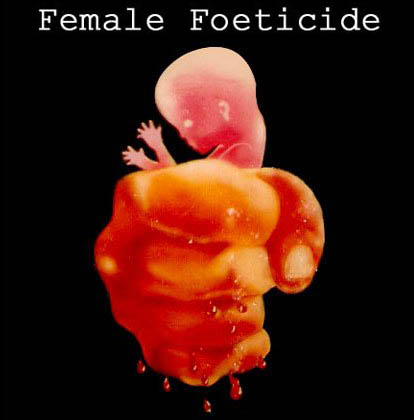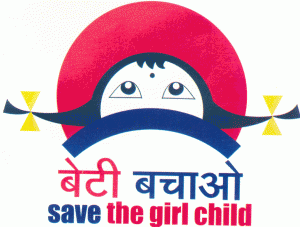This article is written by Saanvi Singla, a student of University Institute of Legal Studies, Panjab University and Tamanna Jindal, a student at University Institute of Legal Studies, Panjab University. They have laid down some of the main reasons which contribute to the heinous crime of female foeticide in India and also discusses the laws which have been made by the government from time to time to eradicate this crime.
They say don’t kill her for she is a mother- the creator, a wife- the companion and a sister- the best friend. I say, let her live not because she is the creator, the companion or the best friend, but because she is a girl equivalent to a boy and a woman equivalent to a man. Don’t protect her just because you need her. Let her live, because you do not have the right to kill her.
Introduction
One of the greatest dangers to our contemporary human progress is the threat of skewed sex proportion. The expanding irregularity amongst males and females is prompting numerous violations, for example, illicit trafficking of ladies, rapes, polygamy and dehumanization of society. These crimes have been on an increase making this world dangerous for women. Female foeticide is a standout amongst the most violent crimes on this planet; maybe what is wretched is that the general population which carries out this heinous crime is amongst the affluent ones.
We all know what female foeticide is. We all know why it is taking place at such a rampant pace. But we should also know the laws which are specifically made to prevent this heinous crime. In this article, we will be discussing the laws which have been made by the government from time to time to stop female foeticide.
Why does female foeticide take place?
These heinous killings of the girl child are advocated mainly on two grounds. One of them is the preference culture. Many scholars believe that female foeticide takes place because of the preference of a male child. They are preferred because they provide manual labor, are the bread earners of the family and succeed the family lineage. The selective abortion of a female child is most common in the areas where cultural norm values a male child over a female child. In a family, son is always considered as an “asset” and daughter, a “liability.”
The second reason is the financial burden. In India, it is considered that having a daughter is a great financial burden. A huge amount of money has to be spent on a daughter’s marriage. Sometimes people have to mortgage their property or even have to sell it for a daughter’s marriage. They sometimes have to take loans that are paid even by the future generations. Due to this reason, a daughter is considered as a financial burden which not many want to bear.
In the case of Voluntary Health Association of Punjab v. Union of India, Hon’ble Justice Dipak Misra observed:
All involved in female foeticide deliberately forget to realize that when the foetus of a girl child is destroyed, a woman of the future is crucified. To put it differently, the present generation invites the sufferings on its own and also sows the seeds of suffering for the future generation, as in the ultimate eventuate, the sex ratio gets affected and leads to manifold social problems.

Origin
During the 1970s it was widely accepted that the root to many major social and economic issues India was facing at the time, was due to its growing population. However, the preference for a male child was predominant in the Indian families and the common practice then was of producing multiple children until a male child was born in the family. This practice was seen as a major threat and the cause for the rapidly increasing population. Aborting female foetuses was viewed as a viable solution to this problem by the government hospitals. The equipment and procedures at the time being complicated and not risk-free, there were not many cases of female foeticide. However, by the late-1980s and the early 1990s, ultrasound techniques gained popularity throughout India and the practice of female foeticide soon spread to hospitals all over India. However soon, this practice was opposed by some activists, and Indian government passed the Preconception and Prenatal Diagnostic Techniques (PCPNDT) Act, 1994 making sex-selective abortion illegal. However, merely making it illegal did not stop it.
Causes
Primary causes
The primary causes of female foeticide in India are patriarchal, safety issues and lack of education
Patriarchy
Patriarchy refers to a social system in which men hold primary power in all spheres of life, such as political leadership, moral authority, control of property, family affairs, etc. Most of the societies in India are patriarchal and most of the patriarchal societies are patrilineal, meaning that the male lineage inherits the property and title. Centuries of patriarchy in India has led to oppression of females and eventually to female foeticide since the early 1990s.
- Gender Discrimination- Centuries of patriarchy has resulted in gender discrimination in all spheres of life. A girl has not been considered as strong, as smart, as intelligent as a boy since times immemorial. Girls had not been allowed to do work such as join the army and police, do heavy-duty jobs, catholic priests, driving buses & trucks and professional pilots, business management, etc. Girls have never been given the real opportunity to make their families proud of themselves.
- A Girl cannot continue the family lineage- According to the patriarchal structure of the society, girls tend to leave their parental home after marriage and move to their matrimonial home. Therefore, it is believed that girls cannot continue the lineage of the family to which they are born. Not only shall the family lineage come to an end, but also, the parents shall be left on their own during their old age.
- The desire of a boy/ son- A boy/son is considered to be a prized possession and a status symbol in the Indian society. It is a prevalent ideology that he will increase the size of the family, be the bread-earner for the entire family and will take care of his parents till their last breath. The desire to procure a son is one of the main causes of female foeticide. Unnecessary and consistent tampering of the religious ideologies has led to the misconception that birth of a boy is a path to heaven. Facing the brunt of such faulty ideas, girls are considered inauspicious and worthless and are therefore killed in the womb.
- Dowry system- The ill-practice of dowry has very deep roots in the India society. A daughter has been looked at as a liability because of the dowry system. The day a girl is born in a family, parents start to worry about the dowry they will have to pay during her marriage and start gathering things and money for her marriage, from the very beginning. Excessive demands for dowry by the in-laws and the subsequent failure on the part of girl’s parents to fulfil such demands lead to the girl being subjected to continuous harassment and torture. To free themselves of such burden and distress, families resort to killing the girls inside the womb.
In the case of the State of H.P. v. Nikku Ram and others, a two-Judge Bench of the Supreme Court has expressed its agony thus: –
“Dowry, dowry and dowry. This is the painful repetition which confronts, and at times haunts, many parents of a girl child in this holy land of ours where, in good old days the belief was : “Yatra Naryastu Pujyante ramente tatra dewatan” (where woman is worshipped, there is abode of God).”
- Alien money (Paraaya Dhan)- Girls are considered as ‘paraaya dhan’ by many parents. They believe that money spent on the upbringing of a girl is total misspending as she will go to her matrimonial home after her marriage. She is considered to be the property of her future in-laws, who will consume various resources of her parental house, but will provide no returns to them. To prevent the wastage of resources of the family, female foeticide is considered a viable act.
Safety issues
Increase in the number of crimes against women with the invasion of India by various intruders, became a cause of concern for families having a girl child. Females have borne the brunt of the declining standards of humanity, respect and demeanour. Eve teasing has become a frequent activity throughout India. Many boys tease girls when they find them alone or even in public places. They pass bad comments regarding their dresses, characters, physical appearances, etc. Heinous crimes such as sexual harassment and rape of women, have become common in India. Protection of females is a major concern of the society. The fear of such crimes being committed with one’s own daughter prove detrimental for some families and therefore, they find, killing the female foetus in the womb of the mother itself, a better option.
Lack of education
Even till date more than 25% of the Indian population continues to be illiterate. Lack of education among Indians has proven to be detrimental for the development on the social and psychological front.
The above graph represents the wide disparity between the male and female literacy ratios and this disparity continues to exist even today. Ill-practices like female foeticide still prevail in India because due to lack of education, people continue to believe in faulty ideas.
Secondary causes
Secondary causes of female foeticide in India are as follows:-
- Misuse of Ultrasound technology– The Ultrasound technology was introduced in India in the early 1990s. Ultrasound scanning machines can be used to fetch a lot of useful information about the early foetus growth during the pregnancy. Unfortunately, many IVF specialists started to misuse this technology to check the sex of the foetus and then abort the unwanted female foetus.
- Corruption in the Medical Field- Corruption is also a factor responsible for female foeticide. The medical profession which was once an honest and respected field of work became corrupt with the passage of time. In an attempt to satisfy their greed, doctors started taking a lot of money to check the gender of the foetus using the ultrasound scan technology and then for abortion of the unwanted female foetus.
Consequences of female foeticide
As the Newton’s Third Law of Motion states, ‘for every action, there is an equal and opposite reaction’, the after effects of this genocide are fatal and have long term effect. It is a disaster that many have unwittingly invited in everybody’s life. Repercussions of female foeticide are long-term and disastrous in nature. Some of them are-
-
Skewed Sex Ratio
In India, the number of girls per 1000 boys is reducing with each passing decade. From 962 and 945 girls for every 1000 boys in the years 1981 and 1991 respectively, the sex ratio had plunged to an all-time low of 927 girls for 1000 boys in 2001.[1]
-
Female/Women Trafficking
The sharp decline in the number of girls makes them sparse for the increasing number of eligible males for marriage. Due to this reason, illegal trafficking of women has become prevalent in many regions. Women, often young girls who’ve just hit puberty, are forced to marry for a price settled by the groom to be. They are normally bought from neighboring areas, where the number of girls might not be as minuscule as the host region. Child marriages have become a rage and child pregnancies, a disastrous consequence.
-
Increase in Rape and Assault
Once women become an imperiled species, it is only a matter of time before the cases of rape, assault and violence become common. Due to the decline in availability of females, the surviving ones are faced with the reality of handling a society driven by a testosterone high. The legal system might offer protection, but many cases might not even surface because of the fear of desolation and humiliation on the girl’s part.
-
Population Decline
With no mothers or wombs to bear a child (male or female), there would be fewer births, leading to a rapid reduction in the country’s population. Though a control in population is the goal of many nations like China and India, a total wipe-out of one sex is certainly not the way to achieve this goal.
Laws that makes female foeticide illegal
Due to all these causes and implications of female foeticide, many laws have been passed from time-to-time to control this menace.
India passed its first abortion-related law in 1971, the so-called Medical Termination of Pregnancy Act, which made abortion legit in almost all states of the country, but it was particularly made for the cases of medical risk to the mother and child conceived by rape. The law had also established physicians who could legally perform the abortion in the said scenarios. But the government had not considered the possibility of female foeticide based on technological advances. Due to this reason, this law proved to be highly ineffective.
During the 1980’s, sex screening technologies in India was easily accessible to the common people. Due to this reason, a large number of reports started pouring in about the abuse of the sex screening technologies. Considering this problem, the Government passed the Pre-natal Diagnostic Techniques Act (PNDT) in 1994. This law was again amended due to various reasons, and it finally became Pre-Conception and Pre-natal Diagnostic Techniques (Regulation and Prevention of Misuse) (PCPNDT) Act in 2004. Its main goal was prevention and punishment of prenatal sex screening and female foeticide.
Implementation of the Law
Many important changes were made in the PCPNDT Act, 2004. It brought ultrasound and amniocentesis under its ambit. It also led to the empowerment of the Central Supervisory Board and the formation of State Level Supervisory Board. The rules, regulations, and punishments are made more stringent.
Despite all these changes, it has been said that the implementation of this act has turned into a farce. It has been nearly two decades since the law came into force and despite this, not many changes have taken place in the society. Despite rulings given by the Supreme Court and various High Courts to make the existing law an impediment, the courts have shown their hesitancy in sending the offenders off to jail. The convicts in many cases have been let off only by a mere warning by the judge which has led to a mass negative reaction from the legal fraternity as well as social and academic activists. Lawyers and activists have unanimously demanded stringent punishment for the guilty while also fixing the accountability of the competent authorities handling the cases of sex detection[2].
Judicial pronouncement
The Judiciary has played and continues to play a vital role in the prevention of atrocities against women, in general, and female foeticide, in particular.
In the landmark case of Centre For Enquiry Into Health And Allied Themes (CEHAT) v. Union Of India & Others, petitioners concerned about the implementation of the Act, moved the Union of India to Court for effective implementation and execution of the provisions of the Pre-Natal Diagnostic Techniques Act, 1994, which had failed at achieving its goals of preventing female feticide. The court warned the Centre, States and Union Territories to effectively comply with the mandates of the Act and also clarified to the appropriate authorities that it was empowered to take criminal action against violators. The Court directed for amendment of the Act in view of emerging technology and the Act was amended in 2003 to Pre-conception and Pre-natal Diagnostic Techniques (Prohibition of Sex Selection) Act, 1994.The Court also directed the formation of the National Committee (National Monitoring and Implementation Committee— NMIC) to monitor the implementation of The Act.
The constitutionality of The PCPNDT Act, 1994 was challenged in Vinod Soni & Anr. v. Union of India on the ground that it violates Article 21 of the Constitution to the extent it includes the liberty of choosing the sex of the child. The petition was dismissed by the Bombay High Court and the Act was held constitutional.
In the case of Voluntary Health Association of Punjab v. Union of India, Petitioner filed a writ petition before the Supreme Court of India to examine the ways in which the Indian state governments have addressed the problem of sex-selective abortion in India. The Court determined that states failed to effectively implement or enforce the Pre-Conception and Pre-Natal Diagnostic Techniques (Prohibition on Sex-Selection) Act, 1994. Justice K.S. Radhakrishnan issued several orders and directions to map out unregistered clinics to ensure they did not purchase ultra-sonography machines, seize illegally sold ultrasonography machines, and hold workshops to inform communities about the Act’s obligations. Justice Dipak Misra observed that, in order to enforce these laws effectively, the awareness campaigns must encompass social and moral impetus for the Act in order to serve the purpose of implementing legislation effectively and to maintain “humanism” and also that, for The Act to be successful the society must be made aware of the equal role of women in society.
Government schemes
Both the Centre and State governments have initiated a range of girl child welfare schemes with an object of changing the social attitude towards the girls and for their upliftment. Following are a few such schemes:-
- Beti Bachao Beti Padhao- It is a central government scheme to save the girl child from sex- selective abortions and advance the education of girl children all over the country. Intitially, the districts having low-sex ratio were targeted.
- Balika Samriddhi Yojana- It is a scholarship scheme designed to provide financial aid to young girls and their mothers below the poverty line. The key objective of the scheme is to improve their status in society and improve the enrollment as well as retention of girls in schools.
- CBSE Udaan Scheme- It is administered by the Central Board of Secondary Education through the Ministry of Human Resource Development, Government of India. This scheme focuses mainly on increasing the enrolment of girls in engineering and other technical colleges throughout the country.
- Ladli Scheme of Haryana- It is a cash incentive scheme initiated by the Haryana Government that provides a payout of Rs. 5000 annually for a period of 5 years to families with a second girl child born on or after 20th August 2015. The money is deposited in a Kisan Vikas Patra. These deposits along with interest are to be released once the concerned girl child becomes a major.
- Karnataka Bhagyashree Scheme- It is a Karnataka government scheme designed to promote the birth of girl child among families below the poverty line. Health insurance cover up to a maximum of Rs. 25,000, is provided to the girl child, annually.
Effectiveness
Despite rulings given by the Supreme Court and various High Courts to make the existing law a practical reality, the implementation of this act has turned into a farce. The legality of Medical Termination of Pregnancy Act, 1971 allows for abortions where pregnancy carries the risk of grave injury to women’s health, therefore, making Ultrasound machines continued to be widely available throughout the country. In such an environment it is very difficult to enforce a law which seeks to control data that whizzes through informal channels and can exercise discreetly.
The various government initiated schemes for the welfare of the girl child focus on the people below poverty line and therefore, fail to incentivize the prevention of sex-selective abortion in comparatively well-off families. Most of the schemes focus on cash-incentives, but the money given out in this regard is actually fuelling the dowry demand. The greed being limitless, the demands are insatiable.
Suggestions
Following are some suggestions to check the evil of female foeticide:
- There is a need to properly implement, not only the laws prohibiting sex-selective abortion, but also, the laws combating various causes of female foeticide, such as
- However, the statutes are not an absolute solution to prevent this practice of female foeticide. To prevent this practice public awareness is essential and no awareness campaign can ever be complete unless there is real focus on the genius of women and the need for women empowerment.
- Medical professionals can play an important role by informing and counselling their patients regarding the gender equality and the impact that a skewed sex ratio has on the society. Women should be made aware about their rights and the ill-effects of abortion.
- More and more States should follow and come up with new ideas such as U.P. government’s ‘Mukhbir Yojana’, launched in 2017. Under this scheme the government provides an incentive of up to Rs 2 lakhs to any person who would alert the state authorities regarding the involvement of any doctor or a medical staff in sex determination of the foetus and/or female foeticide.
- Women empowerment projects, such as Project Shakti and Project Asha Daan by HUL, Sakhi project by Hindustan Zinc, Underprivileged Girl Child Education by DB Corp. Limited, etc should be encouraged under the Corporate Social Responsibility of the business firms.
- Governments should initiate schemes focusing on the well-off strata of the society and providing incentives other than cash.
Conclusion
Through many mediums, awareness about female foeticide is being spread throughout the nation. Let it be plays, soap operas, mass awareness programs, ads, endorsement by various celebrities, Beti Bachao campaign, rallies, posters, etc. Everyone is trying to spread the message everywhere. Despite all these efforts, the sex ratio of our country is not improving.
According to the 2011 Census, there are approximately 110 boys behind 100 girls. This shows that we have wrecked the sex ratio of our country. We can blame the government, the NGO’s or the society as a whole for all we like but till the time the common man does not understand the value of a girl child, this problem will not be solved. The people of this country need to understand that every action has a reaction. Due to rampant female foeticide, the demand for girls for marriage has increased in the whole country. Due to this reason, flesh trade has increased. In one way or the other, it is the female who suffers. We need to understand the importance of a female. After all, they constitute one-half of the society. They should be given the same preference and respect which a male gets in the society.
LawSikho has created a telegram group for exchanging legal knowledge, referrals and various opportunities. You can click on this link and join:
https://t.me/joinchat/J_
Footnotes:
[1]http://www.allresearchjournal.com/archives/2015/vol1issue6/PartC/1-6-20.1.pdf
[2]http://indiatoday.intoday.in/story/law-to-curb-female-foeticide-turns-into-farce-pndt-act/1/455255.html
 Serato DJ Crack 2025Serato DJ PRO Crack
Serato DJ Crack 2025Serato DJ PRO Crack













 Allow notifications
Allow notifications



